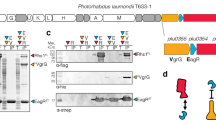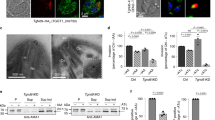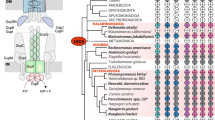Abstract
Most secretory proteins are synthesized as precursor polypeptides carrying N-terminal, Hydrophobie sequences which, by means of a signal recognition particle (SRP)1,3, trigger the membrane transfer of the polypeptide and are subsequently cleaved off. The signal sequences appear to be interchangeable between prokaryotes and eukaryotes4,5. In bacteria, secretion only involves the crossing of a membrane6, whereas in eukaryotes the secretory process can be separated into two distinct phases: translocation across the membrane of the rough endoplasmic retieulum and subsequent intraluminal transport by processes involving vesicle budding and fusion7. Since secretory proteins must be distinguished from other soluble proteins destined for various sites in the reticular system, it is conceivable that eukaryotic secretory proteins possess additional markers distinct from the signal peptide to guide the polypeptide after its transfer through the membrane. Proteins are secreted at different rates from a eukaryotic cell8,34, suggesting a role in intracellular transport for receptors with differing affinities for some topogenic features in secretory proteins. We have tested this possibility by introducing into the lumen of eukaryotic rough endoplasmic reticulum a prokaryotic protein which, by virtue of its origin, had not been adapted to the eukaryotic secretory pathway. We reasoned that secretion of the bacterial protein would indicate that after membrane transfer no topogenic signal(s) and corresponding recognition system(s) are required. We report here that this is indeed the case.
This is a preview of subscription content, access via your institution
Access options
Subscribe to this journal
Receive 51 print issues and online access
$199.00 per year
only $3.90 per issue
Buy this article
- Purchase on Springer Link
- Instant access to full article PDF
Prices may be subject to local taxes which are calculated during checkout
Similar content being viewed by others
References
Walter, P. & Blobel, G. J. Cell Biol. 91, 557–561 (1981).
Walter, P. & Blobel, G. Nature 299, 691–698 (1982).
Blobel, G. & Dobberstein, B. J. Cell Biol. 67, 852–862 (1975).
Talmadge, K., Stahl, S. & Gilbert, W. Proc. natn. Acad. Sci. U.S.A. 77, 3369–3373 (1980).
Müller, M., Ibrahimi, I., Chang, C. N., Walter, P. & Blobel, G. J. biol. Chem. 257, 11860–11863 (1982).
Michaelis, S. & Beckwith, J. A. Rev. Microbiol. 36, 435–465 (1982).
Palade, G. Science 189, 347–358 (1975).
Strous, G. J. A. M. & Lodish, H. F. Cell 22, 709–717 (1980).
Lane, C. D. Cell 24, 281–282 (1981).
Huth, A., Rapoport, T. A. & Kääriäinen, L. EMBO J. 3, 767–771 (1984).
Barnard, E. A., Miledi, R. & Sumikawa, K. Proc. R. Soc. B215, 241–246 (1982).
Roberts, B. E. et al. Proc. natn. Acad. Sci. U.S.A. 72, 1922–1926 (1975).
Contreras, R., Cheroutre, H. & Fiers, W. Nucleic Acids Res. 10, 6353–6362 (1982).
Furuichi, Y., La Fiandra, A. & Shatkin, A. J. Nature 266, 235–239 (1977).
Paterson, B. M. & Rosenberg, M. Nature 279, 692–696 (1979).
Walter, P. & Blobel, G. Proc. natn. Acad. Sci. U.S.A. 77, 7112–7116 (1980).
Roggenkamp, R., Kustermann-Kunn, B. & Hollenberg, C. P. Proc. natn. Acad. Sci. U.S.A. 78, 4466–4470 (1981).
Lockard, R. E. & Lane, C. D. Nucleic Acids Res. 5, 3237–3247 (1978).
Sykes, R. B. & Matthew, M. in Beta-Lactamases (eds Hamilton-Miller, J. M. T. & Smith, J. T.) 17–49 (Academic, New York, 1979).
Eppig, J. J. Jr & Dumont, J. N. Devl Biol. 28, 531–536 (1972).
Rapoport, T. A. Eur. J. Biochem. 115, 665–669 (1980).
Colman, A. & Morser, J. Cell 17, 517–526 (1979).
Hasilik, A. Trends biochem. Sci. 5, 237–240 (1980).
Lane, C. D., Champion, J., Haiml, L. & Kreil, G. Eur. J. Biochem. 113, 273–281 (1981).
Hurkman, W. J., Smith, L. D., Richter, J. & Larkins, B. A. J. Cell Biol. 89, 292–299 (1981).
Walter, P., Ibrahimi, I. & Blobel, G. J. Cell Biol. 91, 545–550 (1981).
Bolivar, F. et al. Gene 2, 95–113 (1977).
Scheele, G. A. & Blackburn, P. Proc. natn. Acad. Sci. U.S.A. 76, 4898–4902 (1979).
Pelham, H. R. B. & Jackson, R. J. Eur. J. Biochem. 67, 247–256 (1976).
Gurdon, J. J. Embryol. exp. Morph. 20, 401–414 (1968).
Soreq, H. & Miskin, R. FEBS Lett. 128, 305–310 (1981).
Laemmli, U. K. Nature 277, 680–685 (1970).
Bonner, W. M. & Laskey, R. A. Eur. J. Biochem. 46, 83–88 (1974).
Lodish, H. F., Kong, N., Snider, M. & Strous, G. J. A. M. Nature 304, 80–83 (1983).
Author information
Authors and Affiliations
Rights and permissions
About this article
Cite this article
Wiedmann, M., Huth, A. & Rapoport, T. Xenopus oocytes can secrete bacterial β-lactamase. Nature 309, 637–639 (1984). https://doi.org/10.1038/309637a0
Received:
Accepted:
Issue Date:
DOI: https://doi.org/10.1038/309637a0
This article is cited by
-
Vectors for Expression of Signal Peptide-Dependent Proteins in Baculovirus/Insect Cell Systems and Their Application to Expression and Purification of the High-Affinity Immunoglobulin Gamma Fc Receptor I in Complex with Its Gamma Chain
Molecular Biotechnology (2018)
-
Leishmania lysosomal targeting signal is recognized by yeast and not by mammalian cells
Parasitology Research (2008)
-
A plant signal sequence enhances the secretion of bacterial ChiA in transgenic tobacco
Plant Molecular Biology (1992)
-
Bacterial ?-lactamase is efficiently secreted in Saccharomyces cerevisiae under control of the invertase signal sequence
Current Genetics (1992)
-
Precursors to regulatory peptides: their proteolytic processing
Experientia (1987)
Comments
By submitting a comment you agree to abide by our Terms and Community Guidelines. If you find something abusive or that does not comply with our terms or guidelines please flag it as inappropriate.



